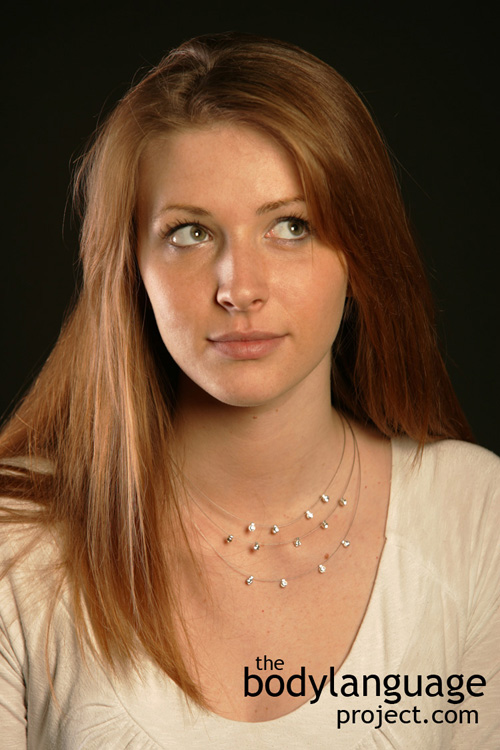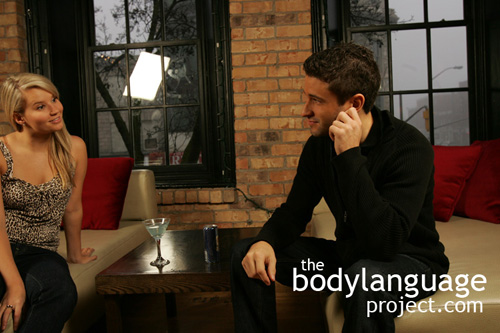Body Language of Eye Blink Rate (Rapid)
 Cue: Eye Blink Rate (Rapid)
Cue: Eye Blink Rate (Rapid)
Synonym(s): Rapid Eye, Blink Rate, Eyes Multiblink
Description: An increase in the rate of blinking.
In One Sentence: Rapid eye blinking is a sign of high stress.
How To Use it: Rapid eye blinking is not useful as a signal as it carries mostly negative connotations. However, the actual act should not be avoided should you require quick action as blinking prepares the eyes for taking in important visual information.
Avoid rapid blinking when you think you will be judged on your honesty as many people attribute a high blink rate to stress, and stress, to lying.
Context: General.
Verbal Translation: “I’m getting ready for action as I have detected some level of stress that requires me to do something or think of something that does not easily come to mind, my eyes are blinking fast to keep them moist and alert.”
Variant: See Eye Flutter or Batting Eyes for a related cue as well as other Eye Language (category). Eyes that blink too slowly (See Eye Blink Rate Less) are usually referred to as Staring or The Evil Eye.
Cue In Action: When asked if she would marry him, her eyes began to blink rapidly – she was stressed and didn’t know how to answer the question since they had only been dating for 3 months.
Meaning and/or Motivation: A high blink rate is often the result of excitement, arousal and stress.
Blinking is the body’s way of preparing us for action as we keep our eyes moist and alert. The normal blink rate is between six and eight times per minute but it can increase by four or five times while under pressure.
Pronounced eye blinking can also happen during sexual arousal and attraction.
A rapid series of eye blinks can also indicate an inner struggle or distress, nervousness and concern.
A high eye blink rate is also associated with lying but it can also be a signal that they are worried about being perceived as liar – so really a high blink rate is only a sign of arousal. One must find the source of the arousal to uncover lying. Eyes that multi-blink where there are a quick succession of rapid eye movement usually signifies high stress and that a person is on the verge of tears. Other times a high eye blink rate means the eyes are dry or that something is stuck in the eye.
Cue Cluster: Watch for a freeze type response, the deer in the headlights where the head freezes in place, the arms and legs seize up, the torso remains still and the face becomes blank or flushes with emotion as a person decides on a course of action.
Body Language Category: Arousal, Autonomic signal, Confused, Eye Language, Fearful body language, Lying or deceptive body language, Nervous body language, Stressful body language.
Resources:
Brefczynski-Lewis, Julie A ; Berrebi, Michael E ; Mcneely, Marie E ; Prostko, Amy L ; Puce, Aina. In the Blink of an Eye: Neural Responses Elicited to Viewing the Eye Blinks of Another Individual. Frontiers in Human Neuroscience. 2011 5.
Brooks, C. I., Church, M. A., & Fraser, L. 1986. Effects of duration of eye contact on judgments of personality characteristics. Journal of Social Psychology. 126: 71–78
Barbato, Giuseppe ; De Padova, Vittoria ; Paolillo, Antonella Raffaella ; Arpaia, Laura ; Russo, Eleonora ; Ficca, Gianluca. Increased spontaneous eye blink rate following prolonged wakefulness. Physiology & Behavior. 2007. 90(1): 151-154.
Condon, William, and W. Ogston (1967). “A Segmentation of Behavior.” In Journal of Psychiatric Research (Vol. 5), pp. 221-35.
Dawson, Michael E. ; Hazlett, Erin A. ; Filion, Diane L. ; Nuechterlein, Keith H. ; Schell, Anne M. Mineka, Susan (editor). Attention and Schizophrenia: Impaired Modulation of the Startle Reflex. Journal of Abnormal Psychology. 1993. 102(4): 633-641.
Drew, G. C. (1951). Variations in reflex blink-rate during visual motor tasks. Quaterly Journal of Experimental Psychology, 3, 73–88.
Davis 1978. Camera Eye-Contact by the Candidates in the Presidential Debates of 1976 Source: The journalism quarterly. 55 (3): 431 -437.
Ellsworth, Phoebe; Carlsmith, J Merrill. 1973. Eye contact and gaze aversion in an aggressive encounter. Journal of Personality and Social Psychology. 28(2): 280-292.
Kanfer, F. (1960). “Verbal Rate, Eyeblink, and Content in Structured Psychiatric Interviews.” In Journal of Abnormal and Social Psychology (Vol. 61, No. 3), pp. 341-47.
Gregersen, Tammy S. Nonverbal Cues: Clues to the Detection of Foreign Language Anxiety. Foreign Language Annals. 2005. 38(3): 388-400
http://bodylanguageproject.com/articles/what-anxious-learners-can-tell-us-about-anxious-body-language-how-to-read-nonverbal-behavior/
Gordon, A. K. and A. G. Miller. 2000. Perspective differences in the construal of lies: is deception in the eye of the beholder? Personality and Social Psychology Bulletin 26 (1): 46-55.
Gilliam, Harold V. B.; Van Den Berg, Sjef. 1980. Different Levels of Eye Contact: Effects on Black and White College Students. Urban Education. 15 (1): 83-92.
Goldman. 1980. Effect of Eye Contact and Distance on the Verbal Reinforcement of Attitude. The Journal of social psychology 111(1): 73 -78.
Greene 1979. Title: Need-Fulfillment and Consistency Theory: Relationships Between Self-Esteem and Eye Contact. Source: Western journal of speech communication. 43(2): 123 -133.
Galin, D. and Ornstein, R., 1974. Individual Differences in Cognitive Style – Reflective Eye Movements; Neuropsychologia, 12: 376-397.
Goldstein, R., Bauer, L. O., & Stern, J. A. (1992). Effect of task difficulty and interstimulus interval on blink parameters. International Journal of Psychophysiology, 13, 111–118.
Holland, M. K., & Tarlow, G. (1972). Blinking and mental load. Psychological Reports, 31, 119–127.
Holland, M. K., & Tarlow, G. (1975). Blinking and thinking. Psychological Reports, 41, 403–406. READ
Huang, Zhinjin ; Stanford, Matthew S. ; Barratt, Ernest S.. Blink rate related to impulsiveness and task demands during performance of event-related potential tasks.
Personality and Individual Differences. 1994. 16(4): 645-648.
Hocking. 1985. Eye contact contrast effects in the employment interview. Communication research reports 2(1): 5-10.
Kinsbourne, M., 1972. Eye and Head Turning Indicates Cerebral Lateralization; Science, 179: 539-541.
Kocel, K., et al.,1972. Lateral Eye Movement and Cognitive Mode; Psychon Sci. 27: 223-224.
Knackstedt, G., & Kleinke, C. L. (1991). Eye contact, gender, and personality judgments. Journal of Social Psychology, 131: 303-304.
Konopacki 1987. Eye Movement Betrays a Prospect’s Inner Feelings Source: Marketing news 21(10): 4.
Karson, Craig N. ; Berman, Karen Faith ; Donnelly, Edward F. ; Mendelson, Wallace B. ; Kleinman, Joel E. ; Wyatt, Richard Jed. Speaking, thinking, and blinking Psychiatry Research. 1981. 5(3): 243-246.
Leal, Sharon ; Vrij, Aldert. Blinking During and After Lying. Journal of Nonverbal Behavior. 2008. 32(4): 187-194.
Mobbs, N.A. 1968. Eye-contact in Relation to Social Introversion-Extraversion. British Journal of Social Clinical Psychology 7: 305-306.
Mann, Samantha ; Ewens, Sarah ; Shaw, Dominic ; Vrij, Aldert ; Leal, Sharon ; Hillman, Jackie. Lying Eyes: Why Liars Seek Deliberate Eye Contact. Psychiatry, Psychology and Law. 2013. 20(3): 452-461.
Mann, Samantha ; Ewens, Sarah ; Shaw, Dominic ; Vrij, Aldert ; Leal, Sharon ; Hillman, Jackie. Eye contact while lying during an interview. Bulletin of the Psychonomic Society. 1976. 7(1): 87-89.
Mann, Samantha ; Ewens, Sarah ; Shaw, Dominic ; Vrij, Aldert ; Leal, Sharon ; Hillman, Jackie. Children’s Knowledge of Deceptive Gaze Cues and Its Relation to Their Actual Lying Behavior. Journal of Experimental Child Psychology. 2009. 103(2): 117-134.
Mann, Samantha ; Ewens, Sarah ; Shaw, Dominic ; Vrij, Aldert ; Leal, Sharon ; Hillman, Jackie. The Lying Chicken and the Gaze Avoidant Egg: Eye Contact, Deception, and Causal Order. Southern Communication Journal. 2006. 71(4): 401-411.
Mann, Samantha ; Ewens, Sarah ; Shaw, Dominic ; Vrij, Aldert ; Leal, Sharon ; Hillman, Jackie. Tell-tale eyes: children’s attribution of gaze aversion as a lying cue.(Author abstract). Developmental Psychology. 2008. 44(6): 1655(13).
Mann, Samantha ; Ewens, Sarah ; Shaw, Dominic ; Vrij, Aldert ; Leal, Sharon ; Hillman, Jackie. ‘Look into my eyes’: can an instruction to maintain eye contact facilitate lie detection? Psychology Crime & Law. 2010. 16(4): 327-348.
Mann, Samantha ; Ewens, Sarah ; Shaw, Dominic ; Vrij, Aldert ; Leal, Sharon ; Hillman, Jackie. Legal Interviewers Use Children’s Affect and Eye Contact Cues to Assess Credibility of Their Testimony. Early Child Development and Care. 2010. 180(3): 397-404.
Navarro, Joe. 2008. What Every BODY is Saying: An Ex-FBI Agent’s Guide to Speed-Reading People. William Morrow Paperbacks.
Porter, Stephen ; Brinke, Leanne. The truth about lies: What works in detecting high-stakes deception? Legal and Criminological Psychology. 2010. 15(1): 57-75.
Rutter, D.C; D. C. Pennington, M. E. Dewey and J. Swain. 1984. Eye-contact as a chance product of individual looking: Implications for the intimacy model of Argyle and Dean. Source: Journal of nonverbal behavior. 8(4): 250-258.
Richard Tessler and Lisa Sushelsky. 1978. Effects of eye contact and social status on the perception of a job applicant in an employment interviewing situation. Journal of Vocational Behavior 13(3): 338-347.
Sitton, Sarah C; Griffin, Susan T. 1981. Detection of deception from clients’ eye contact patterns. Journal of Counseling Psychology. 28(3): 269-271.
Siegle, Greg J ; Ichikawa, Naho ; Steinhauer, Stuart. Blink before and after you think: blinks occur prior to and following cognitive load indexed by pupillary responses.
Psychophysiology. 2008. 45(5): 679-87.
Sugiyama, Toshiko ; Watanabe, Ikue ; Tada, Hideoki. Effects of position and task demands on endogenous eyeblink.(Learning & Memory). Perceptual and Motor Skills. 2013. 116(2): 406(9).
Tada, H ; Yamada, F ; Hariu, T. Changes of eye-blink activities during hypnotic state. Perceptual and motor skills. 1990. 71(3 Pt 1): 832-4.
Tada, H ; Yamada, F ; Hariu, T. Analysis of blink rate patterns in normal subjects. Movement Disorders. 1997. 12(6): 1028-1034.



